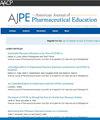Assessing the Alignment Between Pharmacists’ Reported Tasks and Employer-Advertised Skills
IF 3.8
4区 教育学
Q1 EDUCATION, SCIENTIFIC DISCIPLINES
引用次数: 0
Abstract
Objective
This study examined the alignment between and changes within the tasks performed by pharmacists and skills sought by pharmacist employers from 2012 to 2022.
Methods
The United States Department of Labor’s Occupational Information Network (O*NET) surveys a random sample of employees in targeted occupations every 5 years and provides a publicly available database allowing exploration of the frequency with which essential tasks are performed and perceived relevance and importance. Lightcast (formerly Burning Glass) provides labor market analytics of job advertisements; cross-sectional and longitudinal data can be filtered according to occupation, industry, location, and area of specialty. A crosswalk was developed between the top 20 most frequently performed pharmacist tasks (O*NET) and the most frequently-advertised skills by employers for pharmacist positions (Lightcast).
Results
The 5 most frequently performed pharmacist tasks changed minimally over the period, including prescription review and drug information and advice. There was a consistent upward trend in the frequency of interprofessional collaborations and informatics and a downward trend in compounding. Advertised skills fluctuated over the period, with business and management skills most desired. There was a decline in sought-after experience in specific health care settings and some fundamental clinical skills. Emerging skills pertained to patient care, such as vaccination, allergies, diabetes, and wellness.
Conclusion
The fact that prescription review remains the top task from O*NET over the past 10 years and the top advertised skill in Lightcast is patient care underscores the contemporary misalignment and highlights a potential discrepancy in the emphasis of pharmacy education.
评估药剂师报告的任务和雇主广告技能之间的一致性。
目的:本研究探讨了 2012 年至 2022 年期间药剂师所从事的工作与雇主所需技能之间的一致性和变化:本研究探讨了 2012 年至 2022 年期间药剂师执行的任务与药剂师雇主所需的技能之间的一致性和变化:美国劳工部的职业信息网络(O*NET)每 5 年对目标职业的雇员进行一次随机抽样调查,并提供了一个可公开获取的数据库,用于探索执行基本任务的频率以及感知的相关性和重要性。Lightcast(前身为 Burning Glass)提供招聘广告的劳动力市场分析;可根据职业、行业、地点和专业领域过滤横向和纵向数据。在最常执行的前 20 项药剂师任务(O*NET)和雇主最常发布的药剂师职位技能(Lightcast)之间建立了交叉关系:在此期间,药剂师最常执行的 5 项任务变化很小,包括处方审核和药物信息与建议。跨专业合作和信息学的频率呈持续上升趋势,而配制药剂的频率呈下降趋势。在此期间,广告宣传的技能有所波动,最需要的是业务和管理技能。在特定医疗环境中的经验和一些基本临床技能的需求有所下降。新出现的技能与病人护理有关,如疫苗接种、过敏、糖尿病和健康:在过去的 10 年中,处方审核仍然是 O*NET 中的首要任务,而 Lightcast 中宣传的首要技能是病人护理,这一事实强调了当代的错位,并突出了药学教育重点的潜在差异。
本文章由计算机程序翻译,如有差异,请以英文原文为准。
求助全文
约1分钟内获得全文
求助全文
来源期刊
CiteScore
4.30
自引率
15.20%
发文量
114
期刊介绍:
The Journal accepts unsolicited manuscripts that have not been published and are not under consideration for publication elsewhere. The Journal only considers material related to pharmaceutical education for publication. Authors must prepare manuscripts to conform to the Journal style (Author Instructions). All manuscripts are subject to peer review and approval by the editor prior to acceptance for publication. Reviewers are assigned by the editor with the advice of the editorial board as needed. Manuscripts are submitted and processed online (Submit a Manuscript) using Editorial Manager, an online manuscript tracking system that facilitates communication between the editorial office, editor, associate editors, reviewers, and authors.
After a manuscript is accepted, it is scheduled for publication in an upcoming issue of the Journal. All manuscripts are formatted and copyedited, and returned to the author for review and approval of the changes. Approximately 2 weeks prior to publication, the author receives an electronic proof of the article for final review and approval. Authors are not assessed page charges for publication.

 求助内容:
求助内容: 应助结果提醒方式:
应助结果提醒方式:


